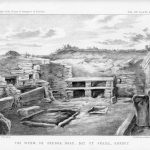

A Skara Brae whodunnit

By Patricia Long
As a tourist guide, I often tell the story of Skara Brae’s discovery. A storm in 1850 showed something strange in the sand at the Bay of Skaill and the Laird, William Graham Watt, went on to excavate part of a 5,000 year old village. After reading the original reports, I now know that this isn’t true. The real story is more interesting.
The Proceedings of the Society of Antiquaries of Scotland, has three papers on Skara Brae. The first was by Samuel Laing, who visited the site in autumn 1866.
“Two chambers have been completely excavated, together with the passage and parts of the entrances to other chambers by Mr William Watt, a relative of William Watt, Esq of Breckness, residing at Skaill, to whose zeal the scientific world is indebted for the discovery and exhumation of this interesting relic of antiquity.”
When I saw the credit being given to a relative of William Watt Esq, rather than the man himself, I remembered my father, Peter Leith, telling me that his father, also Peter, had told him that a different William Watt, known as Black Willie, had been the man responsible.
In the 1861 Census, I found the Laird living at Skaill, aged 84, with a son William, aged 59. His son and heir, William WG Watt was 45 and living at Kierfiold, so there were two sons called William.
In James Irvine’s 2009 book, ‘The Breckness Estate’, I read that William G Watt had a natural son, William, who in 1848 was given £10 a year and free board, “so long as he chose to remain a clerk in the house.”
The story then turned into a neat circle. I followed up a reference in the book and found it was an Orkney Herald article written by my grandfather. It was about Hugh Miller’s book ‘Rambles of a Geologist’, in which Miller recorded his visit to Orkney in 1846.
My grandfather had written: “Another interesting person, who has already been mentioned, was William Watt of Skaill. This was not, as some readers may suppose, the laird of Skaill, but a distant relative who made his home there. He was well-known to everybody as “Black Willie” from his dark hair and complexion. Like Miller, he was a self-taught geologist, he always carried a little bag with a hammer and chisel to dig out any fossils he came across. He brought some of his more interesting specimens for Hugh Miller’s inspection and they had an interesting discussion. When Skarabrae was first dug into in the 1860’s, it is certain that Black Willie took an active part in the work and saw to it that anything found was safely preserved.”
I looked up the references to William Watt in the book and found that Hugh Miller had come with a letter of introduction to him and described him both as an intelligent geologist and an intelligent palaeontologist. He showed Watt, along with Dr Garson of Stromness, where his famous discovery, the Astrolepsis fossil, lay.
To read about the second and third papers on Skara Brae and what Patricia found out, see page 42 of this week’s edition of The Orcadian.
Patricia Long is a tourist guide based in Stenness with a strong interest in social history. She writes a blog at www.aboutorkney.com.